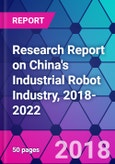Industrial robots are multi-joint manipulators or multi-degree-of-freedom machines for the industrial sector. They are widely used in the industries of automobiles, metal products, electronics, rubber, plastics, etc. In 2017, the global sales of industrial robots exceeded USD 14.7 billion, and the market size in China, Japan, South Korea, the U.S. and German accounted for over 70% of the global total.The CAGR of China's Industrial Robot Market Will Exceed 20% from 2018 to 2022 Says New Report
According to the researcher, from 2007 to 2017, the average wage in China's manufacturing industry more than tripled. Many manufacturers cannot afford the rising labor costs. Affected by government policies, cost pressures and other factors, the production and sales volume of industrial robots in China are rising. In 2013, China became the world's largest industrial robot market. The sales volume of industrial robots (including automatic guided vehicles) in China reached 141,000 units in 2017, increasing by over 58% YOY. However, the current density of robots in China's manufacturing industry is only about 5 per thousand people, far behind that in developed countries.
Due to high R&D costs, domestic enterprises are weak in the technologies of the core industrial robot components, which gives international robot giants strong bargaining power in the supply of the core components. In addition, international giants reduce their manufacturing costs by large-scale factory construction in China. Domestic enterprises are mostly small-sized and lack competitive strength. At present, China-made industrial robots are mainly supplied to low-end markets. The high-end industrial robot market is still occupied by international giants. The Bohai Rim, Yangtze River Delta, Pearl River Delta and Central West China have become the major clusters of China’s industrial robot industry. Domestic industrial robot manufacturers are emerging. Meanwhile, some Chinese enterprises have begun the acquisition of foreign industrial robot manufacturers to enhance their technologies and market share. For example, on Jan. 6, 2017, Midea Group (000333.SZ) announced that it had completed the acquisition of the shares of KUKA Aktiengesellschaft and had made full payment for the acquisition.
With the aging population and rising labor costs in China, low costs and high efficiency will open up the market for industrial robots. As the government promotes the transformation and upgrade of manufacturing and encourages the development of industrial robots, traditional manufacturing industries such as the textile industry and the machinery industry as well as electronic manufacturing have become big growth drivers for the industrial robot market. Moreover, with more mature technologies, domestic-made industrial robots are replacing imports and the market prices will continue to decline, which further stimulates Chinese enterprises' demand for industrial robots. It is estimated that the CAGR of China's industrial robot market will exceed 20% from 2018 to 2022, and the market size will exceed USD 5 billion in 2022.
Topics Covered:
- Development environment of China's industrial robot industry
- Supply of and demand for industrial robots in China
- Competition in China's industrial robot industry
- Major industrial robot enterprises in China
- Factors influencing development of China's industrial robot industry
- Prospect of China's industrial robot industry from 2018 to 2022
Table of Contents
Companies Mentioned
- Asea Brown Boveri Ltd(ABB)
- KUKA Aktiengesellschaft
- FANUC CORPORATION
- YASKAWA Electric Corporation
- Shenyang SIASUN Robot & Automation Co., Ltd.
- Estun Automation Co., Ltd.
- GSK CNC Equipment Co., Ltd.
- Shenzhen Inovance Technology Co., Ltd.
- Nabtesco Corporation
- Harmonic Drive LLC
- Sumitomo Heavy Industries, Ltd
- Shanghai Mechanical & Electrical Industry Co., Ltd.
- Zhejiang Shuanghuan Driveline Co., Ltd.
- Ningbo Zhongda Leader Intelligent Transmission Co., Ltd.
- Nantong Zhenkang Welding Electromachinery Co., Ltd.
- Leader Harmonious Drive Systems Co., Ltd.
- Panasonic Corporation
- Delta Electronics, Inc.
- Mitsubishi Electric
- Siemens
- Guangzhou Start to Sail Industrial Robot Co., Ltd.
- Efort Intelligent Equipment Co., Ltd.
- Shanghai STEP Robotics Corporation
- Bozhon Precision Industry Technology Co., Ltd.
- Dalian Auto-Tech Incorporated Corporation
- Shanghai DEMC Automotive Equipment Manufacturing Co., Ltd.
- Guangzhou Risong Intelligent Technology Co., Ltd.
- Sichuan BMT Welding Equipment & Engineering Co., Ltd.
Methodology
Background research defines the range of products and industries, which proposes the key points of the research. Proper classification will help clients understand the industry and products in the report.
Secondhand material research is a necessary way to push the project into fast progress. The analyst always chooses the data source carefully. Most secondhand data they quote is sourced from an authority in a specific industry or public data source from governments, industrial associations, etc. For some new or niche fields, they also "double-check" data sources and logics before they show them to clients.
Primary research is the key to solve questions, which largely influence the research outputs. The analyst may use methods like mathematics, logical reasoning, scenario thinking, to confirm key data and make the data credible.
The data model is an important analysis method. Calculating through data models with different factors weights can guarantee the outputs objective.
The analyst optimizes the following methods and steps in executing research projects and also forms many special information gathering and processing methods.
1. Analyze the life cycle of the industry to understand the development phase and space.
2. Grasp the key indexes evaluating the market to position clients in the market and formulate development plans
3. Economic, political, social and cultural factors
4. Competitors like a mirror that reflects the overall market and also market differences.
5. Inside and outside the industry, upstream and downstream of the industry chain, show inner competitions
6. Proper estimation of the future is good guidance for strategic planning.

LOADING...








